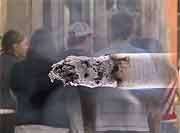(HealthDay)—Intensive interventions aimed at reducing children's exposure to second hand smoke (SHS) at home are effective, according to a study published online Nov. 4 in Pediatrics.
To assess the effectiveness of interventions to reduce children's SHS exposure, Arusyak Harutyunyan, M.D., M.P.H., from the American University of Armenia in Yerevan, and colleagues randomized 250 households with children aged 2 to 6 years to an intensive intervention (counseling sessions, distribution of tailored educational brochures, demonstration of home air pollution, and two follow-up counseling telephone calls) or minimal intervention (distribution of standard leaflets).
The researchers found that the four-month follow-up geometric mean (GM) of hair nicotine concentration was 17 percent lower in the intervention group than in the control group (P = 0.239), after adjustment for baseline hair nicotine concentration, child's age, and gender. In the intervention group, but not in the control group, the GM of hair nicotine decreased significantly from 0.30 to 0.23 ng/mg (P = 0.024). At follow-up, both groups had an increased proportion of households with smoking restrictions and decreased exposure of children to SHS. Children's less-than-daily exposure to SHS was increased in the intervention group at follow-up, with an adjusted odds 1.87 times higher than in the control group (P = 0.077).
"Intensive intervention is effective in decreasing children's exposure to SHS through educating mothers and promoting smoking restrictions at home," the authors write.
More information:
Abstract
Full Text (subscription or payment may be required)
Journal information: Pediatrics
Copyright © 2013 HealthDay. All rights reserved.





















